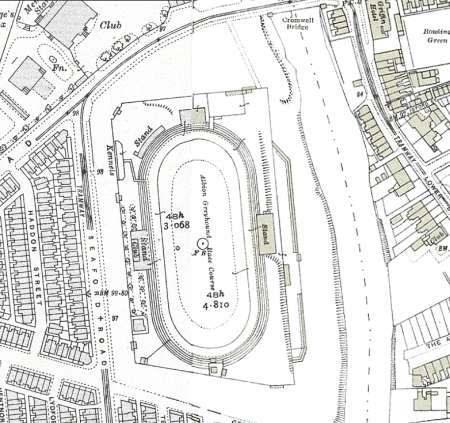Albion Greyhound Racing Track, Cromwell Road, Salford
PENDLETON - The National Greyhound Racing Co., Ltd., propose to construct a greyhound racing track at Cromwell Road, Seaford Road and Gerald Road. Plans are being prepared by Mr. B. Hobson, architect and engineer, 186 Oxford Road, Manchester. [Architect and Building News 2 September 1927 page 404]
Oval track greyhound racing was introduced to the United Kingdom in 1926 and rapidly gained in popularity. In Manchester Belle View Stadium opened in 1926 to instant success and by 1927 schemes for greyhound tracks including at Bolton, Wigan, and White City Trafford, were in hand. In 1927 a syndicate purchased a 10.5 acre site on the west bank of the River Irwell. Bounded by Cromwell Road Seaford Road and Gerald Road it was opposite the entrance to Manchester racecourse, within the township of Pendleton.
With its main entrance on Seaford Road, the design of the stadium was similar to other tracks of the period. There was a stand on either side of the track with tote buildings situated on both sides of each stand. The paddock and racing kennels were located adjacent to the fourth bend while the 140 resident kennels were situated between the stadium and the river. The oval track was 456 yards in length with a long run-up to the first bend and fitted with a ‘Outside Metro-Vickers Mono-rail “hare.” Originally of sand the track was later changed to grass. The stadium had a crowd capacity of 8,000, and during the 1930’s some attendances exceeded six thousand, which contributed to an average of attendance of around 3,000 patrons per meeting. Plans for the stadium were submitted by B. Hobson, architect and engineer, 186 Oxford Road, Manchester who was also the first chairman of Albion Greyhounds Ltd.
The first meeting was held on 7th April 1928 with dirt-track Speedway racing arriving in August of that year. However, this did not prove popular; attendances were low, and after just two seasons the sport moved on. Tuesday and Friday evening racing ended on Friday 30th July 1976. The stadium was compulsorily purchased by the Salford Corporation and demolished for a housing development. Only the street named Greyhound Drive gives a hint of its previous use.
